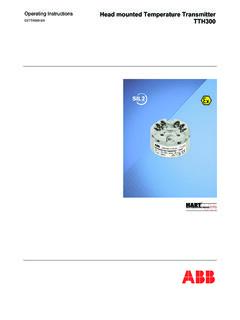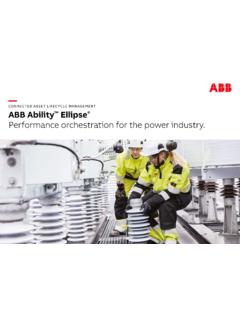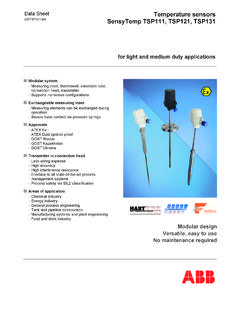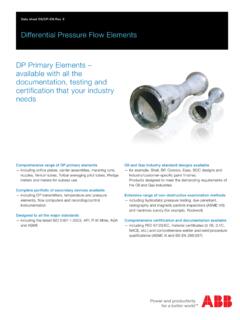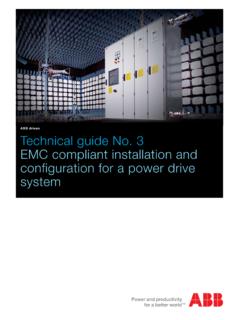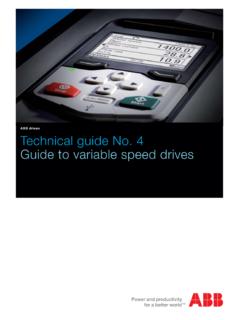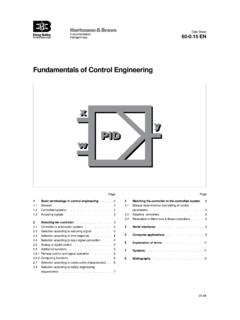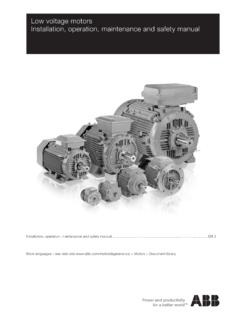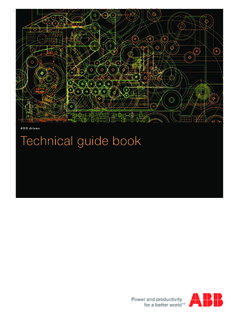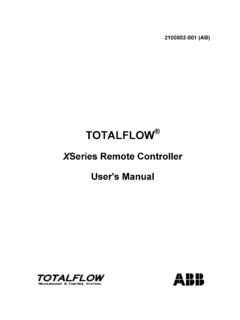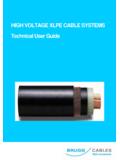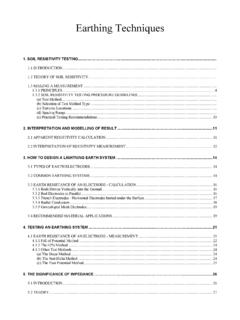Transcription of XLPE Land Cable Systems User´s Guide
1 XLPE Land Cable Systems User s Guide Rev 5. CONTENT. XLPE Land Cable Systems 3. Design, installation and 4. XLPE 4. Cable 4. Installation of XLPE Cable 5. Testing of XLPE Cable 5. XLPE Cable and Cable system .. 6.. 6 6.. 6. ISO 6. XLPE land Cable system .. 7. Trefoil and flat 7. Bonding of metallic .. 7. Current rating for XLPE land Cable .. 8. Current rating for single-core 9. Rating 11. Overload 12. Short-circuit 12. Dynamic forces during short circuit 13. Cable drums - testing - Cable 14. Selection of Cable .. 14. Testing of XLPE 15. Cable 15. XLPE Cable 16. Conductors .. 16. 17. Metallic 17. Non-metallic outer sheath .. 18. Conductive outer layer .. 18. Flame retardant outer 18. Fire 18. Technical data for XLPE land Cable .. 19. 23. 24. Checklist for Cable 25. To make sure you have the latest version of this brochure, have a look at 2 XLPE Land Cable Systems | ABB. INTRODUCTION. Interfaces you can trust ABB manufactures land and submarine power cables up to the highest voltages available.
2 Furthermore, we produce associated joints, terminations and other accessories for all types of cables. The products are designed to work together as a Cable system. Experience you can rely on We have extensive experience of Cable projects all over the world, encompassing every aspect from planning to commis- sioning, including engineering, route surveys, Cable -laying, installation and final testing. Very few manufacturers can point to such a long tradition in the high voltage field as ABB. We delivered our first electrical Cable in 1883 and introduced triple-extruded XLPE cables around 1970. In the early 1970s we started to supply cables for over 100 kV and our first 245. kV XLPE Cable was put into service in 1978. ABB has since then supplied more than 8,800 km of XLPE cables above 100 kV. Experience you can rely on. Research and development ABB has always been a pioneer in the high voltage field and we have many world's first and world records among our references.
3 But there are no shortcuts to success. Maintaining our position calls for innovative research and development, backed up by the wealth of know-how we have accumulated over the years. One of the driving forces for our R&D is to meet the new and constantly increasing requirements from the power industry and a deregulated market. Today we aim to develop the solutions our customers will need tomorrow. State-of-the-art manufacturing lines Experience and state-of-the-art expertise go hand in hand for us. We have been manufacturing cables for over 125 years and have since the beginning been one of the leading produc- ers. Our manufacturing plants are among the most modern in the world and our advanced quality system leaves nothing to chance. Every cubic millimeter of the Cable has to be perfect. We design and produce cables in accordance with interna- tional and national standards or/and according to our custom- ers' specifications. This Guide presents XLPE cables and Systems for land applications mainly.
4 ABB | XLPE Land Cable Systems 3. DESIGN, INSTALLATION AND TESTING. XLPE cables XLPE cables consist of the following components: Conductor Copper (Cu) or Aluminium (Al) stranded compacted conductor or Cu segmental conductor or Cu or Al conductor with key-stone shaped profiles Longitudinal water sealing of conductor Triple extruded and dry cured XLPE insulation system Metallic screen Copper wire screen Copper tape screen Radial water sealing Metallic laminate solidly bonded to outer polyethylene sheath or Lead sheath Longitudinal water sealing of metallic screen Non-metallic outer sheath PE. PVC. Halogen free flame retardant Co-extruded conductive layer over the sheath for special sheath testing Cable accessories ABB's line-up of Cable accessories for ABB XLPE Cable Systems includes: Straight joints and joints with integrated screen separation for cross bonding Transition joints for connection of XLPE to fluid- filled cables Outdoor terminations with porcelain or composite insulators Screened separable connectors for switchgears and transformers Cable terminations for transformers and Gas Insulated Switchgears (GIS).
5 Link boxes for earthing and cross-bonding Distributed Temperature Sensing (DTS) Systems with integrated optical fibre in metallic tube (FIMT). More information about our accessories is available on 4 XLPE Land Cable Systems | ABB. DESIGN, INSTALLATION AND TESTING. Installation of XLPE Cable Systems Installation of Cable Systems includes trenching, Cable pull- ing, clamping of Cable , Cable splicing as well as mounting of accessories. High quality installation work performed by ABB certified field personnel is essential for achieving the low failure rates and reliability performance that is expected from modern underground transmission and distribution circuits. ABB has long and extensive experience from different types of Cable installations including direct burial, duct, shaft, trough, tunnel and submarine installations, but also trenchless tech- nologies like directional drilling, pipe jacking and others. Testing of XLPE Cable Systems Standard routine tests, sample tests, type tests and after lay- ing tests are normally performed according to IEC-standards.
6 Other international or national standards may be followed upon agreement between contractor and purchaser. Routine tests of XLPE cables and accessories PD measurement test High-voltage test of main insulation Electrical test of oversheath Visual inspection Sample tests Sample tests are carried out with a frequency according to applicable IEC standards. Conductor examination Electrical resistance of conductor Check of dimensions Capacitance test Hot set test Electrical tests After laying tests DC voltage test of oversheath AC voltage test of main insulation ABB | XLPE Land Cable Systems 5. XLPE Cable AND Cable SYSTEM STANDARDS. ABB s XLPE Cable Systems are designed to meet require- CENELEC. ments in international and/or national standards. Some of these are listed below. In Europe, Cable standards are issued by CENELEC. (Europe- an Committee for Electrotechnical Standardization.) They are as a rule implementations of the IEC specifications.
7 Special IEC features in design may occur depending on national condi- tions. XLPE Cable Systems specified according to IEC (International Electrotechnical Commission) are among many other stand- HD 620. ards accepted. IEC standards are considered to express an Distribution cables with extruded insulation for rated voltages international consensus of opinion. from ( ) kV up to and including (42) kV. Some frequently used standards are: HD 632. Power cables with extruded insulation and their accesso- IEC 60228 ries for rated voltage above 36 kV (Um=42 kV) up to 150 kV. Conductors of insulated cables. (Um=170 kV). Part 1- General test requirements. Part 1 is based on IEC 60840, and follows that standard IEC 60287 closely. Electric cables - calculation of the current rating. HD 632 is completed with a number of parts and subsections for different cables intended to be used under special condi- IEC 60332 tions which can vary nationally in Europe.
8 Tests on electric cables under fire conditions. IEC 60502 ICEA. Power cables with extruded insulation and their accessories for rated voltage from 1 kV (Um=1,2 kV) up to 30 kV (Um=36 For North America cables are often specified according to kV). ICEA (Insulated Cable Engineers Association, Inc.). IEC 60840 S-97-682. Power cables with extruded insulation and their accesso- Standard for utility shielded power cables rated 5-46 kV. ries for rated voltage above 30 kV (Um=36 kV) up to 150 kV. (Um=170 kV). Test methods and requirements. S-108-720. Standard for extruded insulated power cables rated above 46. IEC 60853 through 345 kV. calculation of the cyclic and emergency current rating of cables. ISO Standards IEC 61443. Short-circuit temperature limits of electric cables with rated ABB has well-developed Systems for quality and environ- voltages above 30 kV (Um=36 kV). mental management which put the needs and wishes of the customer first.
9 Our Systems comply with the requirements of IEC 62067 ISO 9001 and ISO 14001 and are certified by Bureau Veritas Power cables with extruded insulation and their accessories Quality International. for rated voltage above 150 kV (Um=170 kV) up to 500 kV. (Um=550 kV). Test methods and requirements. ISO 14001 and ISO 9001. Certificate of Approval 6 XLPE Land Cable Systems | ABB. XLPE LAND Cable SYSTEM CONFIGURATIONS. Trefoil and flat formation The three cables in a 3-phase circuit can be placed in differ- ent formations. Typical formations include trefoil (triangular). Trefoil or flat formation and flat formations. The choice depends on several factors like screen bonding method, conductor area and available space for installation. Bonding of the metallic screens The electric power losses in a Cable circuit are dependent on the currents flowing in the metallic sheaths of the cables. Therefore, by reducing or eliminating the metallic sheath currents through different methods of bonding, it is possible to incresase the load current carrying capacity (ampacity) of the Cable circuit.
10 The usual bonding methods are described below: Both-ends bonding A system is both ends bonded if the arrangements are such that the Cable sheaths provide path for circulating currents at normal conditions. This will cause losses in the screen, which reduce the Cable current carrying capacity. These losses are smaller for cables in trefoil formation than in flat formation with separation. Single-point bonding A system is single point bonded if the arrangements are such that the Cable sheaths provide no path for the flow of circulat- ing currents or external fault currents. In such case, a voltage will be induced between screens of adjacent phases of the Cable circuit and between screen and earth, but no current will flow. This induced voltage is proportional to the Cable length and current. Single-point bonding can only be used for limited route lengths, but in general the accepted screen volt- age potential limits the length. Cross-bonding A system is cross-bonded if the arrangements are such that the circuit provides electrically continuous sheath runs from earthed termination to earthed termination but with the sheaths so sectionalized and cross-connected in order to eliminate the sheath circulating currents.
